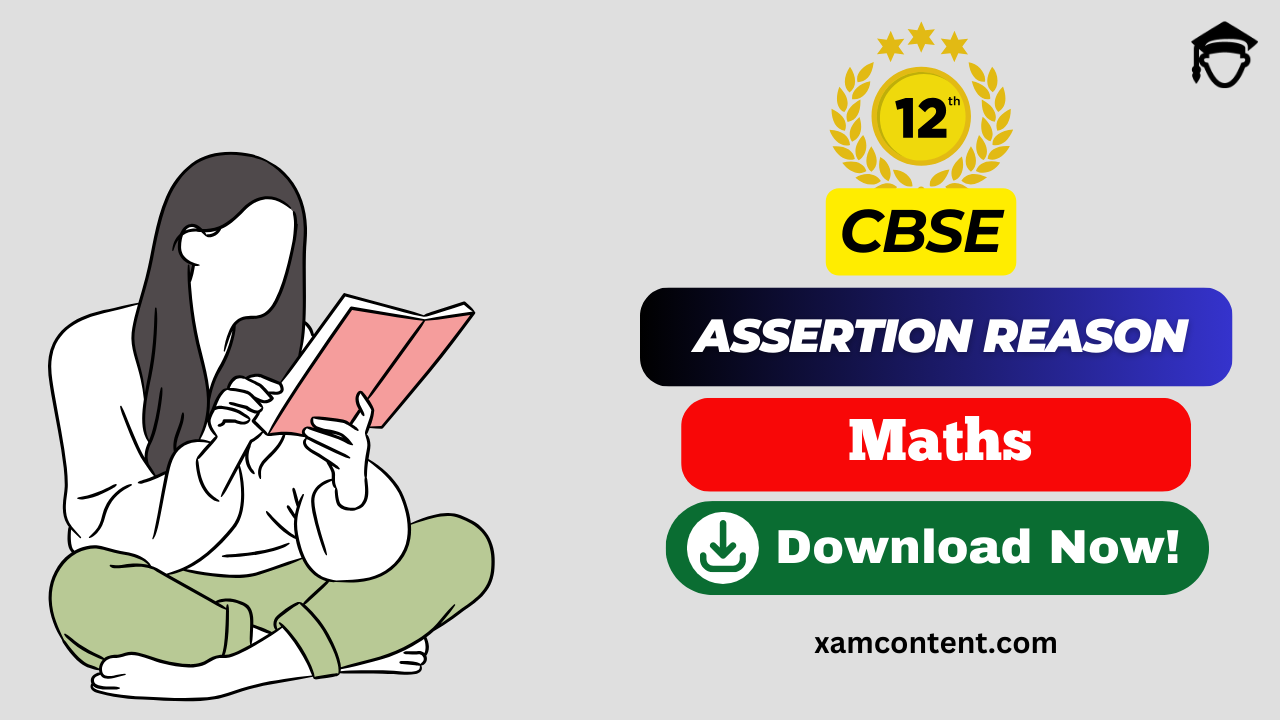Last Updated on April 17, 2025 by XAM CONTENT
Hello students, we are providing assertion reason questions for class 12. Assertion Reason questions are the new question format that is introduced in CBSE board. The resources for assertion reason questions are very less. So, to help students we have created chapterwise assertion reason questions for class 12 maths. In this article, you will find assertion reason questions for CBSE Class 12 Maths Chapter 2 Inverse Trigonometric Functions. It is a part of Assertion Reason Questions for CBSE Class 12 Maths Series.
| Chapter | Inverse Trigonometric Functions |
| Type of Questions | Assertion Reason Questions |
| Nature of Questions | Competency Based Questions |
| Board | CBSE |
| Class | 12 |
| Subject | Maths |
| Useful for | Class 12 Studying Students |
| Answers provided | Yes |
| Difficulty level | Mentioned |
| Important Link | Class 12 Maths Chapterwise Assertion Reason |
Assertion Reason Questions on Inverse Trigonometric Functions
Directions:
In the questions given below, there are two statements marked as Assertion (A) and Reason (R).
Read the statements carefully and choose the correct option:
(A) Both A and R are true, and R is the correct explanation of A.
(B) Both A and R are true, but R is not the correct explanation of A.
(C) A is true, but R is false.
(D) A is false, but R is true.
Q1. Assertion (A): The value of $\sin ^{-1}\left(\sin \frac{5 \pi}{4}\right)=-\frac{3 \pi}{4}$.
Reason (R): The principal value of $\sin ^{-1}(x)$ lies in $\left[-\frac{\pi}{2}, \frac{\pi}{2}\right]$.
Ans. Option (A) is correct.
Explanation: $\sin \frac{5 \pi}{4}=\sin \left(-\frac{3 \pi}{4}\right)$, and since $-\frac{3 \pi}{4}$ is not in the principal range, the actual principal value is within $\left[-\frac{\pi}{2}, \frac{\pi}{2}\right]$, which matches. Both statements are true, and the reason explains the assertion.
Difficulty Level: Medium
Q2. Assertion (A): $\cos ^{-1}\left(\cos \frac{5 \pi}{6}\right)=\frac{5 \pi}{6}$
Reason $(\mathrm{R})$ : The principal value of $\cos ^{-1}(x)$ lies in $[0, \pi]$.
Ans. Option (A) is correct.
Explanation: Since $\frac{5 \pi}{6} \in[0, \pi]$, and cosine is one-one in that interval, the inverse brings back the same angle. The reason directly supports the assertion.
Difficulty Level: Hard
Q3. Assertion (A): $\tan ^{-1}\left(\tan \frac{5 \pi}{4}\right)=-\frac{3 \pi}{4}$
Reason (R): The principal value of $\tan ^{-1}(x)$ lies in $\left(-\frac{\pi}{2}, \frac{\pi}{2}\right)$.
Ans. Option (D) is correct.
Explanation: $\tan \left(\frac{5 \pi}{4}\right)=\tan \left(-\frac{3 \pi}{4}\right)$, but the principal value must lie in $\left(-\frac{\pi}{2}, \frac{\pi}{2}\right)$, so the correct output is $-\frac{3 \pi}{4}$, which lies outside the principal value range. Hence, the assertion is false, but the reason is true.
Difficulty Level: Medium
Q4. Assertion (A): $\sin ^{-1}\left(\frac{3}{5}\right)+\cos ^{-1}\left(\frac{3}{5}\right)=\frac{\pi}{2}$
Reason (R): $\sin ^{-1}(x)+\cos ^{-1}(x)=\frac{\pi}{2}$ for all $x \in[-1,1]$
Ans. Option (A) is correct.
Explanation: This is a known identity of inverse trigonometric functions and holds true for all $x \in[-1,1]$.
The reason explains the assertion exactly.
Difficulty Level: Hard
Q5. Assertion (A): The function $f(x)=\sin ^{-1}(2 x)$ is defined for all real $x$.
Reason (R): The domain of $\sin ^{-1}(x)$ is $[-1,1]$.
Ans. Option (C) is correct.
Explanation: The reason is correct. However, the assertion is false because $\sin ^{-1}(2 x)$ is defined only when $-1 \leq 2 x \leq 1 \Rightarrow x \in\left[-\frac{1}{2}, \frac{1}{2}\right]$, not for all real x .
Difficulty Level: Medium
Also check
- Probability Class 12 Assertion Reason Questions Maths Chapter 13
- Linear Programming Class 12 Assertion Reason Questions Maths Chapter 12
- Three Dimensional Geometry Class 12 Assertion Reason Questions Maths Chapter 11
- Vectors Class 12 Assertion Reason Questions Maths Chapter 10
- Differential Equations Class 12 Assertion Reason Questions Maths Chapter 9
- Applications of the Integrals Class 12 Assertion Reason Questions Maths Chapter 8
- Integrals Class 12 Assertion Reason Questions Maths Chapter 7
- Applications of Derivatives Class 12 Assertion Reason Questions Maths Chapter 6
- Continuity and Differentiability Class 12 Assertion Reason Questions Maths Chapter 5
- Determinants Class 12 Assertion Reason Questions Maths Chapter 4
- Matrices Class 12 Assertion Reason Questions Maths Chapter 3
- Inverse Trigonometric Functions Class 12 Assertion Reason Questions Maths Chapter 2
- Relations and Functions Class 12 Assertion Reason Questions Maths Chapter 1
🚀 Boost Your Exam Prep: Get assertion reason questions for all subjects (Class 6-12) now!
Topics from which assertion reason questions may be asked
- Principal Values
- Basic Properties
- Domain and Range
Inverse trig functions help us reverse angles and solve real-life geometry problems.
Assertion reason questions from the above given topic may be asked.
Download Customised White Label Study Materials in MS Word Format
We are providing teaching resources to teachers and coaching institute looking for customised study materials in MS word format. Our High-quality editable study material which is prepared by the expert faculties are Highly useful for Teachers, Mentors, Tutors, Faculties, Coaching Institutes, Coaching Experts, Tuition Centers.
Frequently Asked Questions (FAQs) on Inverse Trigonometric Functions Assertion Reason Questions Class 12
Q1: What does the chapter ‘Inverse Trigonometric Functions’ cover?
A1: It builds key concepts related to inverse trigonometric functions and prepares you for logical reasoning-based questions.
Q2: What are assertion reason questions?
A2: These consist of two statements: an assertion and a reason. Students need to determine their correctness and relationship.
Q3: Why practice assertion reason questions in Inverse Trigonometric Functions?
A3: They strengthen core concepts and boost confidence in tackling tricky scenarios from inverse trigonometric functions.
Q4: Are assertion reason questions part of CBSE board exams?
A4: Yes, they are included under competency-based formats to test depth of understanding.



